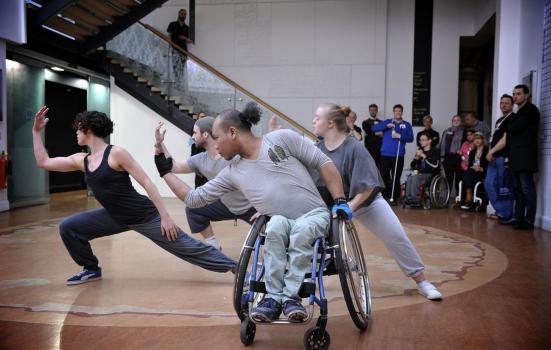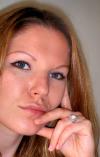Why are we not critically engaging with learning disability arts? Bella Todd reports on the recent Creative Minds conference.

Andy Hood
It’s a bold question to pose, especially at a time when funding cuts conspire to put all creative organisations on the defensive: How do we perceive, discuss and measure quality in work by artists with learning disabilities? Judging by the sell-out attendance for the Creative Minds conference at Brighton Dome in February, which included representatives from Tate, National Portrait Gallery and Sadler’s Wells as well as specialist arts organisations, funding bodies, academics, programmers and practitioners, the question needed to be asked. Only arts critics were, in the main, conspicuously absent from the first stage of what is already a national debate.
Managed and presented by artists with learning disabilities in association with Carousel, Creative Minds was both a showcase for work and an intrepid invitation to interrogate it. We saw work by the Oska Bright film festival, Face Front Inclusive Theatre, Corali and Stopgap dance companies, as well as visual art by Rocket Artists and Thompson Hall from Action Space. Afterwards the artists told us about their development processes and why they felt the results amounted to more than ‘therapy’.
We can all stop saying that work is of artistic value in spite or regardless of its creators’ disabilities
It was the kind of conference, inevitably, where every answer seeds two more questions. This was complicated by the grouping together of artists with diverse disabilities, working in different artforms with varying levels of professional engagement and divergent attitudes as to whether or not to self-identify as learning disabled. And that is before you get started on the subject of how we decide how any art is ‘good’ in the first place. Or, indeed, whether we want to. But the day felt vital – not least because between us we managed so little direct critical engagement with the work on show. Why the collective sidestep? The post-show discussions threw up several revealing exchanges.
One concerned scratch performances. Corali Dance Company uses them, but only to invited guests already familiar with and sympathetic to its style. Another company director in the audience felt work-in-progress showings betray an uncertainty about the work. What made Corali shy away from public scratch nights, and the other company so set on demonstrating assurance at the possible expense of openness? When, as a marginalised voice, you finally win the opportunity to express yourself, how do you feel about listening?
The idea of showing people what we can do also surfaced repeatedly, in answer to questions about both motivation and reception. Laundry Boy by Face Front Inclusive Theatre was good, one audience member with a learning disability had fed back during its tour: “It showed us that disabled people can work in professional arts.” There was a sense that many learning disabled artists are still stuck at the stage of feeling they have to prove they ‘can’.
And no wonder, when discussion of their work is still polarised between indiscriminate rubbishing or words such as ‘refreshing’, which can be just as dismissive of the art. One conference attendee commented in anonymous feedback: “I wouldn’t programme any of the work I saw today in my venue. It’s not of a high quality. Art produced by learning disabled people isn’t of a high quality, generally.” On the other hand, each company had its own bugbear variation on the stock audience member response: “How wonderful that they remembered it all!” Susie Birchwood of Arc Dance Company called for a ban on the word ‘inspirational’. Despite having received several lovely reviews, she said, she longed for her company to receive “feedback that was difficult to hear”.
Being critiqued can be a vital part of growing and improving as an artist. But only if the artist can navigate their own defenses, and only if the critique is honest and, crucially, informed. So how do we get there? A second Creative Minds conference is planned for Bristol in October, and a third for 2015. Creative Minds is also putting together a guide showing artists how to put on their own linked events. These will all be a chance to see how the debate, ticking over in the Talking Area of the Creative Minds website, has progressed.
I hope they will bring us closer to establishing some rules of engagement. Mainstream critics are in danger of overlooking or undervaluing distinctive aesthetic aspects associated with experiences of the world, and ways of being in it, often far removed from their own. Artists with learning disabilities are also in danger of operating in a vacuum. How often do they get to be audience members, or the opportunity and encouragement to be critics themselves? By sharing knowledge and practice in both directions, perhaps we can all stop saying that work is of artistic value 'in spite' or 'regardless' of its creators’ disabilities and start, if and where applicable, saying ‘because’. In an age where all artists are expected to be self-publicists we also need to ensure that blogs and other new platforms provide an opportunity for learning disabled artists to enhance people’s appreciation of their work – not just another accessibility barrier.
There is one thing that the conference made clear to me: from peer reviewers as well as mainstream critics, and in feedback from audience members as well as programmers, we need more real critical engagement. These are professional artists making creative decisions. They deserve something more thoughtful, engaged and, hopefully, constructive than just a thumbs down or a thumbs up.
Bella Todd is a freelance arts journalist based in Brighton.
www.creativemindsproject.org.uk
Tw: @bellatodd1
This article has also appeared on Disability Arts Online.




